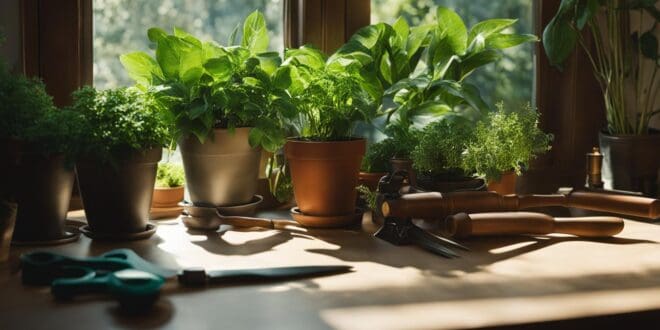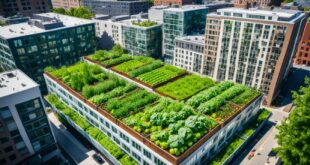Indoor gardening is a wonderful way to bring nature indoors and create a green oasis in your home. Whether you’re a beginner or experienced gardener, these tips will help you grow and care for your indoor houseplants. From choosing the right plants to providing proper lighting and watering, we’ll guide you through the essentials of indoor gardening.
Key Takeaways:
- Choose indoor plants that suit your home’s specific conditions and your personal preferences.
- Provide adequate lighting for your plants by placing them near windows or using artificial grow lights.
- Water your indoor houseplants using the “soak and dry” method to avoid overwatering or underwatering.
- Select pots with drainage holes and use well-draining soil for optimal plant health.
- Fertilize your indoor plants during the active growing season, following the manufacturer’s instructions.
Choosing the Right Indoor Plants for Your Space
When it comes to indoor gardening, selecting the right plants is essential for their overall health and growth. Consider the specific conditions of your home, such as lighting, humidity levels, and available space, when choosing the perfect indoor plants for your space. Here are some popular options to consider:
- Pothos: Pothos is a low-light tolerant plant that thrives in various conditions, making it a great choice for beginners. Its vibrant green leaves can add a touch of freshness to any room.
- Snake Plant: Snake plants are known for their resilience and ability to thrive in low-light environments. They are also excellent air purifiers, making them a popular choice for indoor gardening.
- Orchids: If you’re looking for a flowering plant, orchids are a beautiful option. They require bright, indirect light and proper humidity to bloom and can add an elegant touch to your indoor space.
- Peace Lily: Peace lilies are known for their lush green foliage and white flowers. They thrive in low to medium light conditions and can be a great addition to any indoor garden.
These are just a few examples, but there are many other indoor plants to choose from. Consider your personal preferences and the specific environment in which you will be growing them. By selecting plants that suit your space and caring for them properly, you can create a vibrant and thriving indoor garden.
Maintaining the Right Conditions
Once you’ve chosen the perfect indoor plants, it’s important to maintain the right conditions for their growth. Here are some key factors to consider:
- Lighting: Different plants have varying light requirements. Place your plants near windows to provide them with natural light, or use artificial grow lights for plants that require more brightness.
- Humidity: Some indoor plants thrive in high humidity, while others prefer drier conditions. You can increase humidity by placing a tray filled with water near your plants or by using a humidifier.
- Temperature: Most indoor plants prefer temperatures between 60-75°F (15-24°C). Avoid placing them near drafts or direct heat sources, as it can negatively impact their growth.
- Space: Consider the size of your plants and their growth habits when arranging them. Make sure they have enough room to spread out and grow without overcrowding.
By providing the right conditions for your indoor plants, you can help them thrive and enjoy their beauty in your space. Remember to regularly monitor and adjust these factors as needed.
Providing Adequate Lighting for Your Indoor Plants

Light is an essential factor in the healthy growth of indoor plants. Just like their outdoor counterparts, indoor plants require the right amount of light to thrive. However, unlike outdoor plants that can access natural sunlight, indoor plants rely on artificial light sources. Understanding the light requirements of your plants is crucial to ensuring their well-being.
“Different plants have varying light requirements, with some needing direct sunlight and others thriving in low-light conditions.”
When placing your indoor plants, consider their specific light needs. Some plants, such as succulents and cacti, thrive in direct sunlight and should be positioned near a south-facing window. On the other hand, low-light tolerant plants like snake plants are better suited for rooms with limited natural light. If natural light is insufficient, consider using artificial grow lights to supplement the lighting needs of your plants. LED grow lights are popular options as they provide the right spectrum of light for optimal plant growth.
Rotating your plants
To ensure even growth and prevent your plants from leaning toward the light source, it’s important to rotate them regularly. This simple practice helps to distribute light evenly and encourages balanced growth. Turn your plants by a quarter or a half turn every week or so to maintain their overall health and aesthetics.
Monitoring light intensity
Keep a close eye on the intensity of light your indoor plants are receiving. One way to determine if your plants are getting enough light is by observing their foliage. If the leaves are stretching or leaning toward the light source, it may indicate insufficient light. Conversely, if the leaves are yellowing or browning, it may be a sign of too much light exposure. Adjust the placement of your plants accordingly to ensure they receive the appropriate amount of light.
By providing adequate lighting for your indoor plants, you can create an environment that supports their growth and enhances the beauty of your indoor garden.
Caring for Indoor Houseplants: Proper Watering Techniques
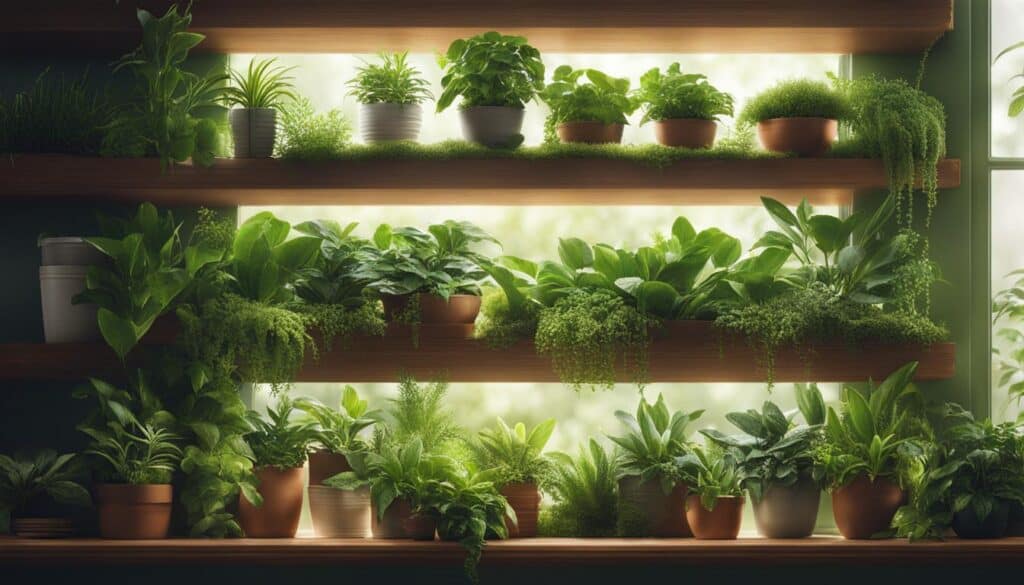
Watering is a vital aspect of indoor plant care, ensuring their health and growth. However, it’s essential to understand the proper techniques to avoid overwatering or underwatering. Most indoor plants prefer a “soak and dry” method, where the soil is thoroughly watered and then allowed to dry out before the next watering.
The frequency of watering depends on various factors, such as the type of plant, pot size, and environmental conditions. To determine if your plant needs watering, check the soil’s moisture level by inserting your finger about an inch deep. If the soil feels dry, it’s time to water. If it’s still moist, wait a few more days.
When watering, ensure that the water reaches the roots and saturates the soil evenly. Be cautious not to let water accumulate in the bottom of the pot, as this can lead to root rot. It’s recommended to use room-temperature water to avoid shocking the plants.
Key tips for proper watering:
- Water thoroughly until water drains out of the pot’s drainage holes.
- Allow the soil to dry out between waterings.
- Consider the plant’s specific water requirements and adjust accordingly.
- Use room-temperature water to prevent temperature shock.
“Proper watering is the key to keeping your indoor houseplants happy and healthy. By understanding your plant’s water needs and following the right techniques, you can ensure their long-term survival and enjoyment.”
Remember that each plant may have unique water requirements, so it’s essential to research and familiarize yourself with the needs of your specific houseplants. By mastering proper watering techniques, you’ll be well on your way to becoming a successful indoor gardener and enjoying the lush beauty of your indoor oasis.
Choosing the Right Pot and Soil for Indoor Plants
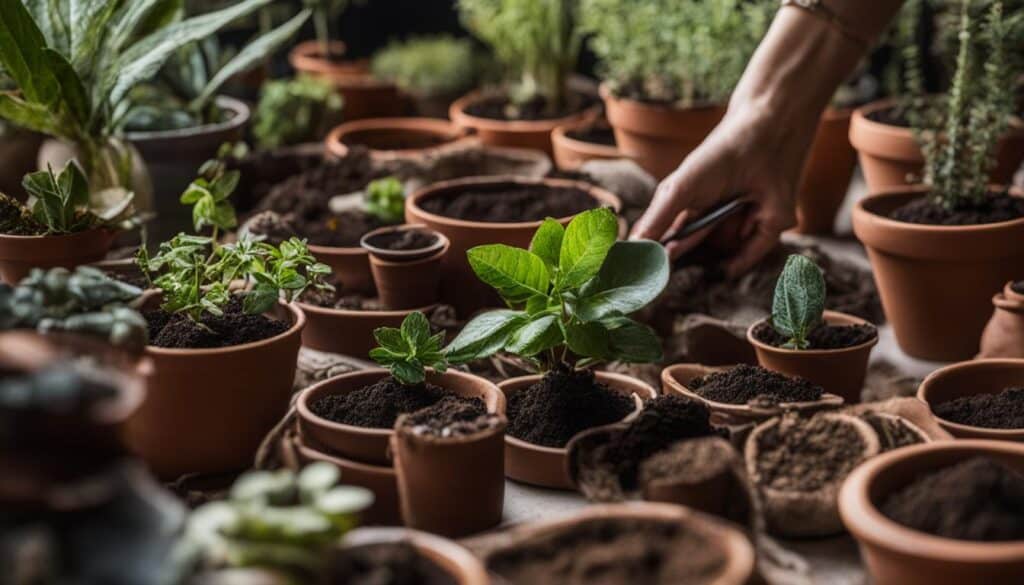
When it comes to potting indoor plants, selecting the right pot and soil is essential for their overall health and growth. The choice of pot and soil can greatly influence how well your plants thrive in an indoor environment. Here are some key considerations to keep in mind:
Choosing the Right Pot
It’s important to choose pots that have drainage holes at the bottom. These holes allow excess water to escape, preventing waterlogging and root rot. Additionally, opting for pots made from breathable materials like clay or terracotta can promote better airflow to the roots.
Choosing the Right Soil
The type of soil you use for your indoor plants is crucial. Look for a well-draining potting mix that allows excess water to flow through easily. Avoid using garden soil, as it can retain too much moisture and lead to root rot. You can find specially formulated indoor potting mixes that are designed to provide the right balance of drainage and moisture retention for indoor plants.
Some indoor plants may have specific soil requirements, such as those that prefer more acidic or alkaline soil. Be sure to research your plant’s specific needs and choose a soil that caters to those requirements.
Remember, as your indoor plants grow, they may outgrow their current pots. Regularly check for signs of root bound plants, such as roots growing out of drainage holes or wrapping tightly around the soil ball. When repotting, choose a pot that is slightly larger than the current one to allow room for growth.
In summary, choosing the right pot and soil for your indoor plants is essential for their overall well-being. Opt for pots with drainage holes and breathable materials, and select a well-draining potting mix that caters to the specific needs of your plants. By providing the right pot and soil conditions, you can ensure that your indoor plants thrive in their environment.
Fertilizing Indoor Houseplants for Optimal Growth
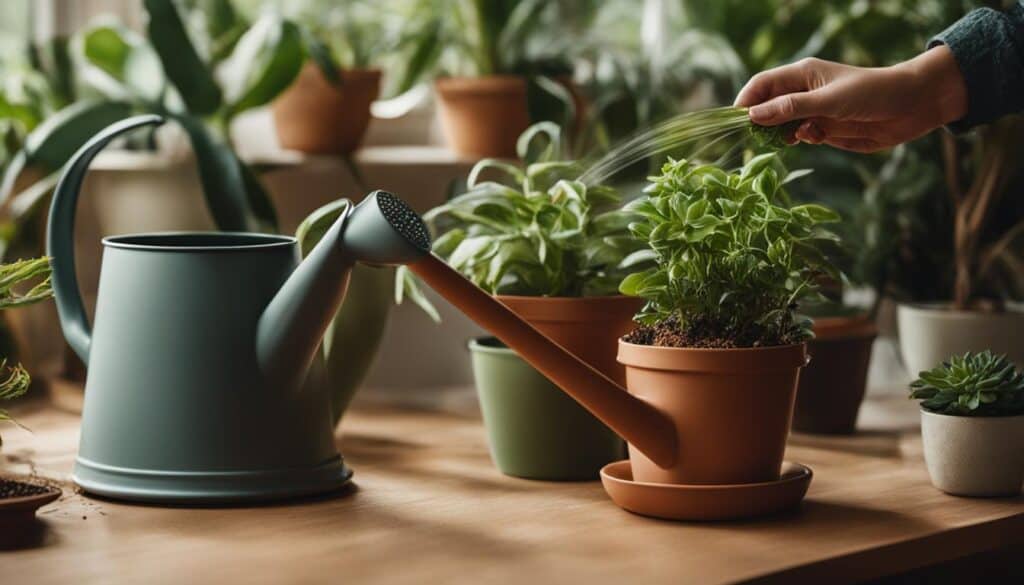
Proper fertilization is essential for the healthy growth and development of your indoor houseplants. While soil provides some nutrients, it may not always contain everything your plants need. Fertilizers supplement the soil with essential plant nutrients, ensuring that your plants receive the right balance of nutrition.
When choosing a fertilizer for your indoor plants, opt for a balanced liquid fertilizer specifically formulated for houseplants. These fertilizers typically contain a mix of nitrogen, phosphorus, and potassium, as well as trace elements like iron and zinc. Follow the manufacturer’s instructions for application rates and frequencies, as overfertilizing can lead to nutrient burn and damage to your plants.
To promote optimal growth, fertilize your indoor houseplants during the active growing season, which is generally in spring and fall. During this time, plants are actively producing new leaves and stems and require more nutrients. Adjust the frequency of fertilization based on the dosage recommendations and the specific needs of your plants.
Remember:
- Choose a balanced liquid fertilizer specifically for indoor plants
- Follow the manufacturer’s instructions for application rates and frequencies
- Fertilize during the active growing season, typically in spring and fall
- Avoid overfertilizing, as it can cause nutrient burn and damage to your plants
By providing your indoor houseplants with the right nutrients at the right time, you’ll ensure their optimal growth and health. Fertilization, when done correctly, can help your plants thrive and flourish in your indoor garden.
Propagating Indoor Plants for Expansion
Propagating indoor plants is an exciting way to expand your collection and add more greenery to your space. By using various propagation methods, you can create new plants from your existing ones, which not only saves money but also allows you to share the joy of gardening with others. Let’s explore some popular propagation techniques and tips to ensure successful plant propagation.
Stem Cuttings
One common method of propagating indoor plants is through stem cuttings. This involves taking a cutting from the parent plant, usually a stem with a few nodes, and placing it in a suitable rooting medium. Make sure to trim the cutting just below a node, remove any lower leaves, and dip the cut end in a rooting hormone to encourage root development. Place the cutting in a jar of water or a pot with a moist soil mix, keeping it in a warm and well-lit area. Mist the cutting regularly to maintain humidity and wait for roots to form before transferring it to a larger pot.
Division
Division is another effective way to propagate certain indoor plants, particularly those with multiple stems or clumps. Carefully remove the plant from its pot and gently separate the root ball into smaller sections. Ensure that each division has a sufficient number of stems and healthy roots. Plant each division in its own pot with fresh soil, taking care not to bury them too deeply. Water thoroughly and provide appropriate care to promote their establishment and growth.
Leaf Cuttings
Leaf cuttings are a unique method of propagation suitable for plants with fleshy leaves, such as succulents and African violets. Simply select a healthy leaf, remove it from the parent plant, and place it in a well-draining soil mix. Insert the cut end of the leaf into the soil, ensuring that it is in contact with the growing medium. Keep the soil lightly moist and provide bright indirect light. Over time, new roots and a small plantlet will emerge from the base of the leaf, eventually growing into a mature plant.
Common Pests and Diseases in Indoor Gardening
Indoor gardening provides a wonderful opportunity to bring nature inside your home, but it also comes with its fair share of challenges. One of the key challenges faced by indoor gardeners is dealing with pests and diseases that can affect the health and vigor of their plants. Understanding common pests and diseases in indoor gardening is crucial for maintaining the overall well-being of your indoor plants.
Common Indoor Plant Pests
Indoor plants are not immune to pests, and some common culprits include spider mites, aphids, and fungus gnats. Spider mites are tiny pests that feed on plant juices and often leave tiny webs on the leaves. Aphids are small insects that suck the sap from plants, leading to distorted growth and the presence of honeydew. Fungus gnats are small flies that lay eggs in the soil, and their larvae feed on plant roots, causing damage and yellowing leaves.
Remember to regularly inspect your plants for signs of pests, such as yellowing leaves, distorted growth, or the presence of webs. Early detection and intervention can help prevent pest infestations from spreading and causing extensive damage.
Common Plant Diseases
In addition to pests, indoor plants can also be susceptible to various diseases. Some common plant diseases in indoor gardening include powdery mildew and root rot. Powdery mildew presents as a white, powdery coating on the leaves and stems, often caused by high humidity or poor air circulation. Root rot occurs when the roots of plants are constantly sitting in wet soil, leading to the decay and eventual death of the roots.
- To prevent powdery mildew, ensure good air circulation around your plants and maintain proper humidity levels.
- To prevent root rot, make sure your pots have drainage holes and avoid overwatering your plants.
Implementing good cultural practices such as proper watering, regular monitoring, and maintaining a clean growing environment can go a long way in preventing and managing common plant diseases in indoor gardening.
Troubleshooting Common Indoor Plant Problems
Indoor gardening can sometimes present challenges, but with the right knowledge and care, you can overcome common issues that arise with your indoor plants. Here are some helpful plant care tips to troubleshoot and address common problems:
1. Yellowing Leaves:
If you notice yellowing leaves on your indoor plants, it may be a sign of overwatering, nutrient deficiencies, or poor lighting conditions. To address this issue, adjust your watering schedule and make sure the soil is draining properly. Consider fertilizing your plants with a balanced fertilizer to provide them with the necessary nutrients. Additionally, ensure that your plants are receiving adequate light based on their specific requirements.
2. Wilting:
Wilting leaves can be a sign of underwatering or root issues. To remedy this problem, check the moisture level of the soil and water your plants accordingly. Ensure that the pots have drainage holes to prevent water from sitting in the bottom and causing root rot. If the roots are damaged or overcrowded, consider repotting your plants into a larger container with fresh soil.
3. Pest Infestations:
Pests such as spider mites, aphids, and fungus gnats can wreak havoc on your indoor plants. To combat these pests, regularly inspect your plants for any signs of infestation and take immediate action. Use organic pest control methods such as neem oil or insecticidal soap to eliminate the pests. It’s also important to keep your plants clean and free from debris as pests can hide in the soil and plant crevices.
By addressing these common indoor plant problems promptly and with the right care, you can ensure the health and well-being of your indoor plants. Remember to research specific plant care tips for your particular plant species to provide them with the best possible care.
Enhancing the Indoor Gardening Experience
Indoor gardening goes beyond just caring for plants; it’s also about creating a beautiful and inviting space in your home. By incorporating stylish pots, plant stands, and other decorative elements, you can transform your indoor garden into a vibrant and visually appealing oasis.
When it comes to choosing pots for your indoor plants, opt for designs that complement your home decor. Consider the size, shape, and color of the pots to create a cohesive and aesthetically pleasing look. From sleek and modern to rustic and bohemian, there are countless options available to suit your personal style.
To add an extra touch of elegance to your indoor garden, invest in some well-crafted plant stands. These stands not only elevate your plants but also add dimension and visual interest to the space. Choose stands with different heights and materials to create a dynamic and balanced display.
Lastly, don’t forget to regularly clean and dust your indoor plants to keep them looking their best. Dust can accumulate on leaves over time, hindering their ability to photosynthesize effectively. Use a soft cloth or sponge to gently wipe down the leaves and remove any dirt or debris. This simple maintenance routine will help your plants stay healthy and vibrant for years to come.
Creating a Green Oasis: Quick Tips
- Choose pots that complement your home decor
- Invest in well-crafted plant stands for added elegance
- Regularly clean and dust your indoor plants to keep them looking their best
Conclusion
Indoor gardening is not just a hobby; it’s a way to bring nature into your home and create a tranquil atmosphere. By following these tips for indoor plant care, you can ensure the success of your houseplants and enjoy their beauty and benefits.
Remember to choose the right plants for your specific indoor environment, considering factors like lighting and humidity levels. Provide adequate lighting, whether through natural sunlight or artificial grow lights, and be mindful of each plant’s specific light requirements. When it comes to watering, find the balance between overwatering and underwatering by following the “soak and dry” method and adjusting based on plant type and environmental conditions.
Additionally, selecting the right pots and soil, fertilizing your plants during the growing season, and propagating them for expansion are all ways to enhance your indoor gardening experience. By addressing common plant problems and staying vigilant against pests and diseases, you can ensure the health and vitality of your indoor garden.
Indoor gardening is an art that requires patience and care, but the rewards are well worth the effort. So go ahead, create your own green oasis and enjoy the wonders of indoor gardening!
 Fullersears
Fullersears
